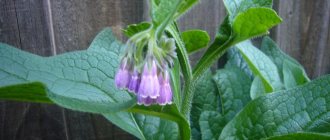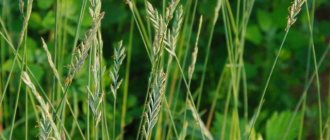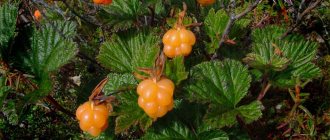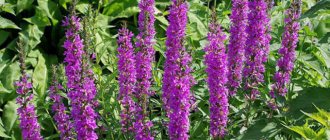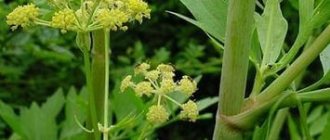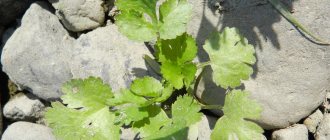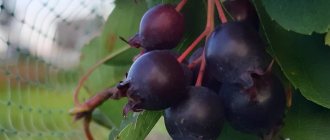What is amaranth
Amaranth is popularly called amaranth, amaranth, foxtail, cat's tail, cockscombs, and axamite.
It got its name because the flowers do not lose their shape for a long time and retain it when dried. Literally translated from Greek as an immortal flower (“a” - negation, “mara” - goddess of death, “anthos” - flower). There is an opinion that it was named so because, due to its healing properties contained in the plant, it prolongs youth, maintaining health and good spirits.
Beneficial features
The healing and nutritional properties of amaranth are unique and surpass all known species in terms of the concentration of nutrients in one plant. Including ginseng and golden mustache.
Serotonin, a hormone of good mood, is synthesized naturally in amaranth. Taking amaranth preparations significantly increases vitality, improves mood, and relieves stress. It is recommended to use it in moderation; overdoses lead to the opposite results - depression and drowsiness.
The magnesium content in ashiritsa in sufficiently large quantities makes it useful for the heart and for strengthening the cardiovascular system.
The antioxidants contained in the culture cleanse the body, remove toxins, and preserve youth. Therefore, it is important to use amaranth components for residents of megacities and people employed in hazardous industries.
Amaranth protein contains, along with other amino acids, one essential amino acid - lysine, which is vital for the body. Lysine is not synthesized independently in the body; it comes only from food. The lysine content in ashiritsa is twice as much as in wheat protein and three times more than in corn and sorghum.
Lysine helps in the production of antibodies, and even helps in killing viruses
The presence of squalene in the plant allows it to saturate all tissues of the body with oxygen. The content of the unique component squalene in amaranth oil is much higher than in any other vegetable oil. For example, 30 times more than in olive oil.
The vitamin K contained in the plant helps in cleansing the body of excess cholesterol and improves blood circulation. Vitamin K in combination with squalene regulates the process of blood clotting and prevents internal bleeding. Amaranth is used to treat heart attack, stroke, hypertension and angina.
Amaranth grains do not contain gluten, so they are used in a gluten-free diet.
The juice from the leaves contains starch, carotene, ascorbic acid, potassium and tannins. Used in complex therapy to relieve many inflammatory processes.
This is a universal-purpose crop - it is used as food, as a medicine, in animal husbandry, in perfumery, and as an ornamental plant.
The protein in the chemical composition of amaranth surpasses all animal and vegetable proteins in its value and quality. Amaranth is the leader in complete protein content. Corn is more of a carbohydrate product, and amaranth is more proteinaceous. The protein content in amaranth leaves is up to 20%, in seeds up to 23%, and the completeness of the protein is estimated to be up to 97%
↑ Eating amaranth
Eating amaranth is a book that has begun to be written again. And there is one interesting page in this book. At a time when amaranth was already anathematized, Queen Christina Augusta of Sweden founded the Order of the Knights of Amaranth in 1653, which lasted three years (until the introduction of Christianity in Sweden).
The symbol of the order was a wreath of amaranth, on which shone the image of an amaranth and two intertwined, inverted letters “A”. Members of the order dined on Sundays with the queen, eating various dishes from this plant: porridge, cold soups like okroshka, healing high-calorie drinks.
Perhaps the establishment of the order was connected not only with the queen’s love affairs at the mill, where the Swedes ground amaranth grains, but also with its well-known property of “igniting the fire of love” and the Indian belief that eating the “golden grain of God” helps to become a god-like superman. And this episode in the history of the “mystical grain of the Aztecs” for many years was only a glimmer in the darkness of oblivion of the miracle plant.
The nutritional properties of amaranth are difficult to overestimate. For comparison: the nutritional value of amaranth protein is 75 units, and milk is only 72 units. Roots, stems, leaves, flowers and seeds, to one degree or another, are a source of oil, starch, vitamins, pectin, carotene, protein, trace elements, mineral salts, sugar.
This is a whole storehouse of unique protein of the highest quality, containing lysine - the most valuable and essential amino acid for the human body, which contains 6-9% in protein, which is significantly more than in the protein of corn, wheat, and rice. In Japan, the nutritional value of amaranth greens is compared to squid meat.
Flour and cereals from amaranth seeds are used as valuable food additives (up to 20%) in the production of dietary food products: cereals, bakery products, pasta, confectionery products, and baby food. When it is added to wheat flour (10%), baked bread and pastries acquire healing properties and do not go stale for a long time.
Already, more than thirty types of amaranth-containing food products are produced in different countries of the world: noodles, pasta, sauces, chips, biscuits, muffins, waffles, cookies, soft drinks and beer. And this, in essence, is only the beginning of the great procession across the planet of the “golden grain of God,” called, according to N.I. Vavilov, to feed humanity. There is no doubt about one thing - amaranth simply must be included in our daily diet!
Young amaranth leaves taste similar to spinach. They are consumed fresh, dried and canned. They are used in salads, soups, meat and fish dishes, in the preparation of sauces, casseroles, as fillings for pies, teas are brewed and added to compotes, healing juice is obtained and syrups are made from it. Amaranth greens are prepared for future use by drying and freezing.
The seeds, first of all, are a source of oil with wonderful properties, more valuable than sea buckthorn. They can be eaten fried. When heated, the grains crack and acquire a pleasant nutty taste. Fried and raw, they are added to casseroles, pancakes, puddings, cakes, and baked goods.
It’s not at all difficult to invent salads with amaranth yourself, since it goes well with any salad vegetables. We can say that “you can’t ruin a salad with amaranth.” With traditional spring vitamin deficiency, any dishes and drinks with this extraordinary greenery will help to quickly eliminate vitamin deficiency. Here are some recipes for amaranth dishes:
SALAD:
200 g of amaranth leaves and 200 g of nettle leaves, 50 g of wild garlic leaves (can be replaced with leaves of young winter garlic) pour over boiling water, chop, salt, season with vegetable oil or sour cream.
SHI:
add 400 grams of amaranth leaves and 100 grams of sorrel leaves to 500 ml of meat or chicken broth with boiled potatoes (before this, put the leaves in boiling water for 3 minutes); cook for 10 minutes, remove from heat, break 2 raw eggs, lightly beat and pour into the broth, stirring continuously; When serving, add sour cream to taste.
SAUCE:
in a deep bowl, bring 300 g of cream to a boil, put 200 g of finely chopped young amaranth leaves into the cream; Add 100 g of grated soft cheese and 5 g of ground black pepper to the hot mixture, put it back on low heat, stir until the cheese is completely melted.
CUTLETS:
fry 50 g of amaranth seeds, make a puree from boiled potatoes (100 g) and peas (100 g), grate carrots (50 g); mix all products thoroughly with the addition of 2 raw eggs; Make small cutlets, roll them in breadcrumbs or flour, fry in vegetable oil.
GREEN CUTLETS:
prepare minced meat from 200 g of blanched amaranth leaves (dip in boiling salted water for 3 minutes, chop), 50 g of grated mild cheese with a clove of garlic and 50 g of white bread pulp, 2 tablespoons of wheat flour; add 2 raw eggs, ground black pepper and salt to taste to the minced meat; if necessary, dilute with a small amount of cream; Roll the cutlets in breadcrumbs and fry in olive oil.
BITS:
prepare minced meat from 200 g of fried amaranth seeds or flour, 150 g of minced meat (beef, poultry), 2 eggs, salt to taste; Roll the formed meatballs in wheat flour, lightly fry over high heat. Stew in tomato sauce with fried onions and carrots.
TEA:
a tablespoon of fresh or dried amaranth leaves and flowers (can be replaced with seeds) and half a teaspoon of lemon balm or mint, brew 100 g of water heated to 70 degrees; hold in a closed container for 5-7 minutes, add boiling water to 200 g; sugar or honey - to taste.
DRINK “CHIVILITY”:
Rub 4-5 large ripe tomatoes through a sieve (remove the skins first). Pour a glass of sour bread kvass or fermented milk drink Tan (Ayran, Kumis) into the resulting puree, add 7-8 crushed amaranth leaves, a quarter of a dessert spoon of ground black pepper. Beat the mixture until smooth. The drink is ready to drink. It is especially recommended for the male population as a folk “green Viagra”.
Spreading
Amaranth is the oldest plant; its use has been known for 8 thousand years. South America is officially considered its homeland; thanks to the Spanish conquerors, the plant spread to Asia and later to Europe.
- Amaranth has taken root well in Northern India and China. This plant is still cultivated there and is highly valued.
- In Europe, this plant was received coolly and was used mainly as an ornamental. Over the years, different types of crops were pollinated and gradually lost valuable qualities, turning into weeds.
- In Japan, amaranth is valued as highly as squid meat.
Chemical composition of amaranth
All parts of the plant have biological value and are used for their intended purpose. The seeds have the highest nutritional value. The concentration of plant chemical elements varies depending on the type of plant.
But all types of amaranth contain:
- Easily digestible protein;
- Polyunsaturated acids and biologically active substances;
- Vitamins B, A, C, E, K, PP, flavonoids, carotenoids and pectin;
- Microelements Fe, Cu, Se, P;
- Macroelements Na, Mg, K, Ca, Mn
Amaranth seeds have the highest nutritional value.
The protein content in amaranth seeds is the same as in soybeans or meat. And in terms of protein digestibility it is superior to these products. It is important that amaranth seeds do not contain gluten (gluten), a component of all grain crops, so it is included in the diet of people with allergies to this protein (gluten).
Amaranth fatty acids contain a whole complex of acids - oleic, linoleic, linolenic.
Squalene hydrocarbon is the most valuable substance contained in amaranth seeds. Squalene actively participates in the process of saturating all tissues of the body with oxygen, thereby increasing blood circulation and removing accumulated harmful toxins from the body.
Squalene is an excellent antioxidant. This quality of squalene allows the use of amaranth in the fight against malignant tumors in oncology. Squalene is also found in shark liver, but in this case it is much more expensive to synthesize.
Squalene also helps regulate lipid and steroid metabolism in the body, and takes part in the synthesis of vitamin D in the body. The component squalene is used in the treatment of atherosclerosis.
Traditional medicine recipes with amaranth
The Indians were the first to appreciate the beneficial properties of the herb. Amaranth is valued in folk medicine for its antibacterial, hemostatic and anti-inflammatory properties. The seeds and leaves have a general strengthening effect and are able to fully provide the body with all the necessary vitamins, macro- and microelements. Self-medication with amaranth can be harmful to health. Therefore, you need to consult your doctor.
Amaranth oil is a source of large amounts of vitamins and acids. It has a pronounced anti-inflammatory property and is actively used both in medicine and in cosmetology.
Amaranth decoction
The main component is a plant mixture (dried crushed leaves, roots and flowers of amaranth). Fresh, finely chopped roots are equally beneficial.
You need to pour 2 tbsp. l. mixture (about 15 g) 200 ml of boiling water, boil for 10 minutes over low heat. The broth is cooled and filtered. Take half a glass three times a day half an hour before meals. It has a general strengthening property. Improves taste 1 tsp. honey and ½ tsp. lemon juice.
Amaranth infusion
The classic infusion is prepared from 1 tbsp. l. chopped amaranth leaf and 1 tbsp. water. It is boiled in a water bath for a minute, then boiling water is added to the original volume.
Take 2 sips chilled 30 minutes before meals for 2 weeks to treat the gastrointestinal tract. Rinse the gums, taking advantage of the anti-inflammatory properties. Tampons with shiritsa infusion will ease menstrual syndrome and are useful for the prevention of ovarian cysts.
A remedy for diseases of the genitourinary system and enuresis is prepared from fresh leaves. For this, 3 tbsp. l. Finely chopped leaves are poured into 1 liter of boiling water for 6 hours. Take a glass before bedtime.
Bath with amaranth
The anti-inflammatory and regenerating properties of the plant are used in the treatment of insect bites, burns, bedsores and skin diseases. Take baths with amaranth 3 times a week for half an hour. They are harmful to people with exacerbation of pancreatitis, urolithiasis, and cholecystitis.
To prepare in a water bath, boil 400 g of crushed leaves and stems in 2 liters of water for 15 minutes. The mixture is filtered and poured into a full bath.
Amaranth tea
It contains no caffeine, so there will be no harm from frequent use. There is a noticeable benefit as an additional remedy in treating the body from:
- diabetes mellitus;
- anemia;
- painful menstrual syndrome;
- problems with lactation;
- arthritis, arthrosis and osteochondrosis;
- insomnia, nervous system disorders;
- acute and chronic respiratory diseases;
- for weight loss.
To brew healthy tea, you need to pour 1 tbsp. l. dry or fresh amaranth leaves and inflorescences and ½ tsp. mint 100 ml hot water (~80 °C), leave in a closed kettle for 7 minutes. Then add another 100 ml of boiling water and a spoonful of honey for a more pleasant taste.
We recommend reading: Mint tea: beneficial properties and contraindications, how to make
Medicinal properties of amaranth
In traditional medicine, amaranth is used as a source of biologically active substances - amaranthine, rutin, carotenoids. A whole complex of active components that make up amaranth is used for the prevention and treatment of many diseases.
The most unique qualities of the plant are stimulation of growth and tissue regeneration, the ability to reduce inflammation, and prevent complications of diseases.
Amaranth has enormous bioenergetic activity; it is the best immune activator of natural origin. The use of amaranth in the treatment of the genitourinary system, diseases of the gastrointestinal tract, diseases caused by metabolic disorders and diabetes, obesity, vitamin deficiency, and anemia is well known.
Amaranth oil, which contains the unique triterpene hydrocarbon squalene, is considered the elixir of life. It is increasingly used in the treatment and prevention of diseases.
This is a real panacea for restoring the skin, it treats and heals wounds, eczema, helps restore damaged internal organs, also due to chemotherapy and radiation therapy.
The healing properties of amaranth are also used in cardiology; the active components of the plant help strengthen the walls of blood vessels and get rid of cholesterol deposits on the walls of blood vessels. Thereby helping to reduce high blood pressure.
How to raise a lizard
As already noted, amaranth is an easily adaptable plant, so it can grow in almost any conditions. But it is better to sow when the earth warms up and there is enough moisture in the soil. With proper sowing, weed control will become irrelevant - the ashes will “crush” unwanted neighbors. To obtain early shoots, agarica can be sown not in spring, but in autumn - before the first frost.
Amaranth is sowed in rows (the distance between which is at least 45 cm), and the space between plants should not be less than 7-10 cm. Otherwise, you should not expect a big harvest. Compost, humus, nitroaminophosphate, phosphates, potassium or nitrogen agents are used as fertilizer during sowing.
Gatherings appear after 10 days. At the initial stage of germination, it is important to thin out the plants to the required planting density. The plants are fertilized the second time when they reach 20 cm. During growth, it is important to provide the required amount of moisture, then the agaric will grow quite quickly - up to 7 cm daily.
The appearance of a panicle on the acorn grass is a sign that it is time to harvest. This usually occurs 110 days after sowing. However, it is important to remember that the maturation of all panicles does not occur simultaneously. Therefore, the crop is harvested as the seeds ripen.
Clean the seeds by sifting through a sieve. After drying, they are ready for sowing again. Dry grains are also suitable for cooking. The agaric crop can also be pickled or frozen.
Amaranth as a medicine:
- In cases of intestinal dysfunction, hemorrhoids, heavy menstruation, and inflammatory processes in the genitourinary system, a water infusion of amaranth is used.
- To treat dysentery and jaundice, a decoction of the roots and seeds of the plant is used.
- Amaranth juice will help against malignant tumors.
- Burns, bedsores, scars, insect bites are treated with amaranth oil.
- Inflammation of the mucous membranes of the mouth can be cured by rinsing with agaric acid (take 5 parts of water for 1 part juice).
Pharmacological properties of amaranth
Pharmacologists and doctors consider pharmacological preparations based on the active components that make up amaranth to be an effective natural remedy for the prevention and treatment of diseases. Today, medical preparations containing amaranth:
- Rectal-vaginal suppositories with oil extract of amaranth seed. Indicated for fungal and infectious diseases of the vagina or rectum, hemorrhoids, anal fissures, ulcers, proctitis, urethritis.
- Ointments and balms used for diseases of joints and muscle tissue. Contains a complex of plant components, including amaranth. Increases blood circulation and normalizes metabolic processes in the periarticular and muscle areas. Prescribed for arthritis, arthrosis, osteochondrosis, for physical damage to joints and periarticular muscles and ligaments.
- Gels and tablets are used to treat the skin disease vitiligo, as well as after burns and other skin damage. These preparations use the active component squalene based on amaranth.
- Tablets based on amaranth seed with the addition of succinic and nicotinic acids. Used for the prevention and treatment of cardiovascular diseases.
- Drugs that lower the level of low-density lipoproteins, i.e. cholesterol. Amaranth oil extract is the basis of the drug.
- BIO supplements are biologically active preparations, the main active ingredient of which is amaranth oil. The drug is effective only with a corrective diet.
- Preparations with squalene, the active component of amaranth, in capsules, are used for the prevention and complex therapy of various diseases, for recovery after serious illnesses and operations.
Contraindications
Biologically active elements found in amaranth are in concentrated form, the concentration is especially high in oil and in extracts from amaranth.
This is a potent medicine and the use of drugs is not recommended for people with:
- With cholelithiasis, acute cholecystitis, as it can provoke the movement of stones along the bile ducts and their blockage, which is life-threatening;
- With acute pancreatic disease, acute pancreatitis;
- During the period of exacerbation of diseases of the gastrointestinal tract;
- People with an allergic reaction to amaranth.
The benefits of amaranth for pregnant women and children
Shchiritsa is useful for pregnant women and babies. The leaves and seeds contain a lot of folic acid. This vitamin is especially useful during the first weeks of pregnancy. Its deficiency harms the formation and development of the child’s brain and spinal cord.
Children are given 1 tsp daily. amaranth juice with a drop of honey. This dose contains the daily requirement of protein. Taking ashiritsa stimulates the growth and development of children and becomes the key to their health.
Attention! Before taking amaranth juice or infusion, you should consult your doctor or pediatrician. An allergic reaction is possible, it will not cause any other harm.
Growing amaranth
In agriculture
Scientists and breeders believe that amaranth is the future of agriculture. What is valuable is that its cultivation productivity is high. The optimal density is 75 thousand plants per hectare, one plant weighs 4 kg, multiplying it to get 300 tons per hectare.
Amaranth is the easiest crop to grow; it is drought-resistant, as it contains a powerful root system and is able to use ground dew formed due to temperature changes. During dry periods, amaranth leaves are also able to retain moisture by curling into a tube.
The plant easily adapts to changes in the surrounding climate, seed germination is maintained for 5 years, and under good seed storage conditions up to 40 years.
On a personal plot
There are also no problems with growing plants on a personal plot. Grain and vegetable amaranth has lighter green tones, while the decorative variety is darker with bright, rich colors. The most valuable varieties of amaranth in terms of the content of useful substances and recommended for household plots:
- Valentina is a productive variety for seeds. It reaches a height of up to 1.7 m, early ripening - 4 months from the moment of planting it produces ripened seeds.
- Krepysh is a persistent, strong and early ripening variety. Leaves and seeds are used.
- White Leaf is a white amaranth, dwarf, plant height 20 cm, has a pleasant delicate taste.
Valentina
Strong White Leaf
Having planted amaranth on your plot, you will notice that the plants neighboring it are no longer afraid of diseases and have become more productive.
Amaranth is an unpretentious plant and easy to care for. Resistant to any diseases. It can be planted with seeds, but it is best to use seedlings; it loves a sunny place and loose, fertile soil. The strength of the plant is revealed 30-40 days after planting, at which time it begins to grow powerfully, giving an increase of 5-8 cm per day.
At the end of June, in July, it is recommended to pinch the plant to develop side shoots. The best fertilizing would be nitrogen fertilizers; it is better to apply fertilizing in the morning while watering at the root of the plant.
The healing properties appear when the plant reaches 20 cm in height, after which the leaves can be picked and used in a tea drink or for external use. The seeds are collected in September, when the flower panicles gradually change color and become heavier. The spikelets are cut off and dried in a dark, dry place.
Decorative amaranth varieties Bulava and Vera will decorate your garden plot with charismatic beauty.
How to grow, care and pests and diseases
- Planting is needed in moist, drained soil, at a temperature of 25-30 degrees at the end of May. The potting method is suitable for growing seedlings.
- Adapts well to new conditions. Grows in different soil conditions.
- Does not tolerate loamy, waterlogged and floating soils.
- The embedment depth is 1-1.5 centimeters.
- Mandatory weeding and regular watering. Fertilizing is needed 3-4 times per season (mullein solution 1:5) and ash (200 g per 10 liters of water).
- Leaves are not cut, only dried ones are removed.
- Amaranth is resistant to pests and diseases. But you should be afraid of aphids and weevils.
Historical reference
South America, Peru, and Mexico are officially considered the homeland of amaranth. The Aborigines used this crop as a grain crop and the name was corresponding to “Indian bread.” Although it is not a grain, bread was baked from it and porridge was cooked.
And in pre-Petrine Russia (the period before the reign of Peter I), bread was baked from amaranth seeds. During excavations near Novgorod, amaranth seeds were found. Amaranth was the main food of the Slavic people. In Rus', men have always been famous for their excellent health, strength and longevity. Subsequently, amaranth was undeservedly forgotten for many years.
Why this happened is not known for certain, but after the reforms of Peter I, the diet in Rus' gradually changed, became poorer, many healthy foods were banned and the diet was populated with foreign products, including tobacco. The Bolsheviks continued the food genocide after Peter I.
The culture was undeservedly forgotten, partly due to its wrong reputation. The bright red synthetic dye was called amaranth, but it turned out to be carcinogenic. This dye has nothing to do with the amaranth plant. Fatal coincidence of names.
Genetic breeder, scientist Nikolai Ivanovich Vavilov, after a trip to Mexico in 1930, carried out work to study the unique qualities of amaranth seeds and oil, trying to attract attention to this crop. But most of the works were lost. Is it a coincidence? It took 60 long years for people to become interested in this culture. The more scientists study this plant, the more amazing facts they learn.
Now, with the support of scientists and specialists in breeding and agronomy, thanks to laboratory research, amaranth is being revived. St. Petersburg, Chelyabinsk, Kazan, Voronezh and other research centers regularly hold seminars and forums on Amaranth, sharing experience in growing and using it in the food and medical industries.
Types and varieties
Paniculate or purple amaranth (Amaranthus paniculatus = Amaranthus cruentus)
Most often used for decorating flower beds and making bouquets, including winter ones. This is an annual plant with a height of 75 to 150 cm with elongated, ovate, red-brown leaves with a sharp, elongated tip. Small red flowers are collected in erect inflorescences. This species blooms in June and blooms until cold weather. In cultivation since 1798, it has several forms: nana - a low-growing form up to 50 cm high, cruentus - with drooping inflorescences of red flowers, sanguineus - vertical inflorescences with hanging ends.
- Astrantia: growing from seeds, types and varieties
Most often, low-growing varieties with a height of 25-40 cm are used in floriculture:
- Rother Dam and Rother Paris - varieties 50-60 cm high with dark red foliage and dark burgundy flowers;
- Zwergfakel and Grunefakel - varieties up to 35 cm high with purple and dark green inflorescences, respectively;
- Hot Biscuit is the tallest variety, reaching a meter in height, with green foliage and red-orange inflorescences.
Dark or sad amaranth (Amaranthus hypochondriacus)
A low-branched species up to one and a half meters high with oblong-lanceolate pointed leaves of purple or purple-green color and vertical spike-shaped panicles of inflorescences of various colors, but most often dark red. In culture since 1548. There is a blood-red form - sanguineus, with hanging inflorescences.
Varieties:
- Pygmy Torch - amaranth 60 cm in height, the dark purple inflorescences of which turn chestnut in the fall, and the leaves become multi-colored;
- Green Thumb is a variety up to 40 cm high, colored in different emerald tones and often used by phytodesigners when composing dry bouquets.
Tricolor amaranth (Amaranthus tricolor)
Decorative deciduous plant from 70 cm to one and a half meters high with erect stems forming a pyramidal bush. The leaves of tricolor amaranth are elongated, ovate or narrow, sometimes wavy, colored in combinations of yellow, green and red - young leaves are unusually bright and beautiful. It blooms from June until frost, has several varieties: willow (salicifolius) with narrow, bronze-green wavy leaves up to 20 cm long and half a centimeter wide; red-green (rubriviridis) with leaves of a ruby-violet hue with green spots; red (ruber) with blood-red leaves and bright (splendens), which has dark green leaves with brown spots.
Varieties:
- amaranth Illumination is a powerful plant up to 70 cm high with spectacular large leaves. Young leaves are red-yellow, and older ones are red-orange, the lower leaves are bronze in color;
- Aurora - this variety has wavy apical leaves of a golden yellow hue;
- Earlie Splender - apical leaves of a bright crimson hue, lower ones - almost black with a purple-green tint.
Amaranthus caudatus
It grows naturally in tropical Africa, Asia and South America. The stems are powerful, erect, up to one and a half meters high. The leaves are large, elongated-ovate, green or purple-green in color. Small dark red, yellowish-green or crimson flowers are collected in spherical balls, which in turn are arranged in long hanging paniculate inflorescences. This species blooms from June to October, in cultivation since 1568. It has several forms: white-flowered - with greenish-white flowers; green - this form with pale green inflorescences is in great demand among florists; bead-shaped - flowers of this shape are collected in a whorl and look like long beads strung on a stem.
Varieties:
- Rotshvants - with red inflorescences;
- Grunschwanz - with light green inflorescences.
Both varieties reach a height of 75 cm and are powerful bushes that occupy a large space.

